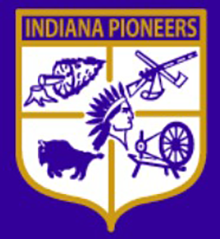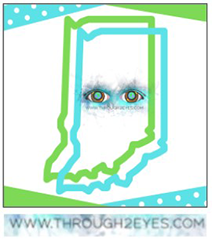
Saturdays, noon to 1 p.m. ET on WICR 88.7 FM.
Or stream audio live from anywhere on WICR Online!
December 18, 2021
The Green Book and Indiana sites
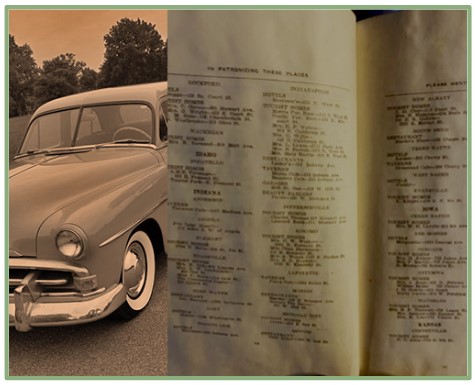
 The Green Book was an annual guidebook for African America motorists during an era of widespread discrimination. Published from the mid-1930s through the mid-1960s, the Green Book listed hotels, restaurants, gasoline stations and other sites that welcomed all travelers.
The Green Book was an annual guidebook for African America motorists during an era of widespread discrimination. Published from the mid-1930s through the mid-1960s, the Green Book listed hotels, restaurants, gasoline stations and other sites that welcomed all travelers.
Because sites across Indiana were included in most editions of the book that became known as the "bible of Black traveling", Hoosier History Live will explore them with a popular guide for Indiana history tours. Sampson Levingston of Through2Eyes will be Nelson’s guest to share insights about the impact of The Green Book and about the Indiana sites, many of them long gone.
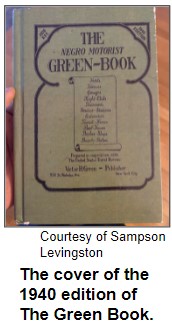 A history storyteller known as the "walk and talk guy", Sampson owns a 1940 edition of the Green Book, which lists sites in nearly 20 Indiana cities and towns. Indianapolis had the most sites (with 13), followed by Evansville (5), Kokomo (4) and New Albany (3). Several cities and towns had just a single site listed.
A history storyteller known as the "walk and talk guy", Sampson owns a 1940 edition of the Green Book, which lists sites in nearly 20 Indiana cities and towns. Indianapolis had the most sites (with 13), followed by Evansville (5), Kokomo (4) and New Albany (3). Several cities and towns had just a single site listed.
But, in the case of Angola in far northeastern Indiana, that single listing was for an entire resort community that’s still flourishing. Fox Lake, a resort consisting of cottages built beginning in the mid-1930s, became a seasonal refuge for African Americans who were prohibited from owning or renting summer residences at other lakeside communities.
At the opposite end of the state, southern Indiana, a hotel in West Baden was built for African American guests who were not welcomed at lavish resort hotels in the region. So the Waddy Hotel was listed in several editions of the Green Book; its celebrity guests included world heavyweight boxing champion Joe Louis. The Waddy Hotel burned in 1951 and was never rebuilt, according to Indiana Landmarks.
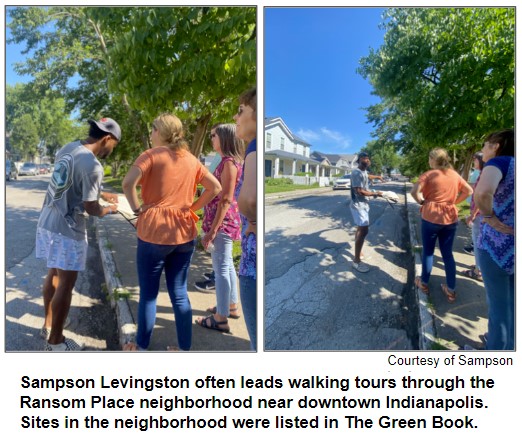
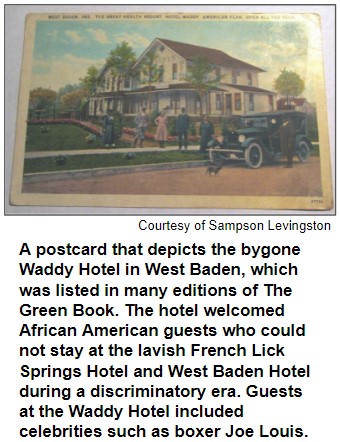 Even though many sites no longer stand, the Green Book has attracted renewed public interest since the success of the 2018 movie The Green Book that featured an Academy Award-winning performance by actor Mahershala Ali. He portrayed an acclaimed jazz musician traveling during the early 1960s through the Deep South.
Even though many sites no longer stand, the Green Book has attracted renewed public interest since the success of the 2018 movie The Green Book that featured an Academy Award-winning performance by actor Mahershala Ali. He portrayed an acclaimed jazz musician traveling during the early 1960s through the Deep South.
In Indianapolis, our guest Sampson Levingston leads walking tours on Indiana Avenue as well as in the nearby Ransom Place neighborhood; both had sites frequently listed in the Green Book.
Sampson joined Nelson last August for an all call-in show about visits by famous Americans to Indiana. During that show, Sampson referred to sites in the Hoosier state listed in the Green Book, but we did not have time to do a deep dive into them, or to discuss the importance of the Green Book.
The guidebook’s name was derived from its founder, New York-based publisher Victor Hugo Green. After his death in 1960, his widow, Alma, oversaw editions during its final years.Roadtrip: Riley’s colorful Christmas poems for children
 "A defective Santa Claus" or "Once they wuz a Santy Claus"? Who knew that the Hoosier Poet, James Whitcomb Riley (1849 to 1916), wrote some rather colorful Christmas poems? Well, he did write over 1000 works of poetry!
"A defective Santa Claus" or "Once they wuz a Santy Claus"? Who knew that the Hoosier Poet, James Whitcomb Riley (1849 to 1916), wrote some rather colorful Christmas poems? Well, he did write over 1000 works of poetry!
We’ll have a special treat on Saturday as the Hoosier Poet will be calling in from his home at 528 Lockerbie Street in downtown Indianapolis. While Riley resided at the home he had become a national celebrity, charming his audiences with his “dialect poetry” which celebrated the attitude and vernacular of the Indiana countryside.
And our Riley in “real life” is none other than historic reenactor Danny Russel of Famous Hoosiers. Coming up is the festive holiday banter between Danny and Nelson. And our Riley in “real life” is none other than historic reenactor Danny Russel of Famous Hoosiers. Coming up is the festive holiday banter between Danny and Nelson.
From the Hoosier History archives
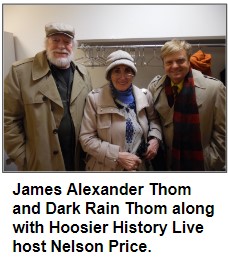 Historical fiction writers James Alexander Thom and Dark Rain Thom, along with Hoosier History Live host Nelson Price, at the December 2017 Holiday Author Fair at the Indiana History Center. Jim and Dark Rain were also spotted at this year’s Holiday Author Fair; and both in fine form! The literary couple reside in a remote cabin in Owen County, Indiana.
Historical fiction writers James Alexander Thom and Dark Rain Thom, along with Hoosier History Live host Nelson Price, at the December 2017 Holiday Author Fair at the Indiana History Center. Jim and Dark Rain were also spotted at this year’s Holiday Author Fair; and both in fine form! The literary couple reside in a remote cabin in Owen County, Indiana.
Holiday musings from Hoosier History Live
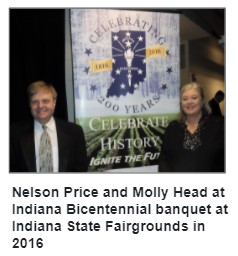 As we travel about this holiday season, it does seem that many of you do appreciate the unusual program that we put together. We are nothing if not persistent.
As we travel about this holiday season, it does seem that many of you do appreciate the unusual program that we put together. We are nothing if not persistent.
Thanks for the generous individual contributions made, primarily by visiting the yellow ”donate” button on our website and e-newsletter. By the way, recent contributors are listed in our e-newsletter, and all contributors are listed by year on our website under the “Support the show” page.
And we continue to solicit sponsorship, which includes logos, links, and live credits in the show. It’s grim work, but the show must go on!
Let’s continue to celebrate one of the best shows on radio!
Nelson Price, host and historian
Molly Head, producer/general manager, (317) 506-7164
Ryan DeRome, associate producer
Cheryl Lamb, administrative manager
Richard Sullivan, senior tech consultant
Pam Fraizer, graphic designer
Garry Chilluffo, consultant
Please tell our sponsors that you appreciate their support!

 Acknowledgments to WICR-FM, Fraizer Designs, The Indiana Album, Monomedia, Indiana Historical Bureau, Indiana Landmarks, Henri Pensis, Kielynn Talley, Genesis Brown, Heather McIntyre, and many other individuals and organizations. We are independently produced and are self-supporting through organizational sponsorship and through individual contribution at the yellow button on our newsletter or website. For organizational sponsorship, which includes logos, links, and voiced credits in the show, contact Molly Head at (317) 506-7164 or email her at molly@hoosierhistorylive.org. Our media reach continues to grow via podcasting.
Acknowledgments to WICR-FM, Fraizer Designs, The Indiana Album, Monomedia, Indiana Historical Bureau, Indiana Landmarks, Henri Pensis, Kielynn Talley, Genesis Brown, Heather McIntyre, and many other individuals and organizations. We are independently produced and are self-supporting through organizational sponsorship and through individual contribution at the yellow button on our newsletter or website. For organizational sponsorship, which includes logos, links, and voiced credits in the show, contact Molly Head at (317) 506-7164 or email her at molly@hoosierhistorylive.org. Our media reach continues to grow via podcasting.
Thank you!
We'd like to thank the following recent individual contributors who make this show possible. A complete list of contributors by year in on our website.
- Phil and Pam Brooks
- Clarke Kahlo
- Steve Giese
- Rachel Perry
- Dr. & Mrs. William H. Dick
- John and Flo Stanton
- Bob Levy and Kathy Alexander
- Margaret and Stephen Smith
- Laura and William Selm
- Stacia Gorge
- David Yount
- Madalyn Kinsey
- Charles Schisla
- Anonymous
- Greg Larson
- David and Theresa Berghoff
- Tom Swenson
- Kathleen Angelone
- Dr. William McNiece
- Michael Freeland and Sharon Butsch Freeland
- Ryan Zumbahlen
© 2021 Hoosier History Live. All rights reserved.
|
